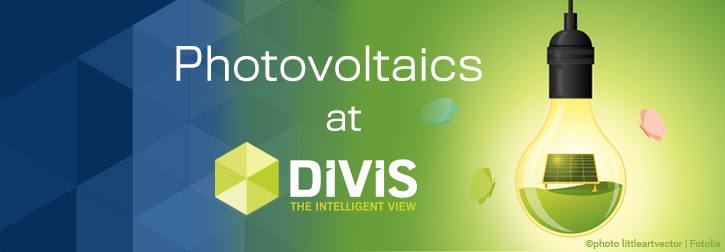Green power: Photovoltaic system on the roof of the DIVIS headquarters
Bordesholm, November 25, 2017

DIVIS stands for value-driven business actions and sustainability in every sense. That is true for the solutions we develop for our customers, and beyond. This includes the solar power system on the roof of the DIVIS premises in Bordesholm. The system, installed in 2013, works with a capacity of 54.6 kWp (kilowatt peak) and covers almost 50% of DIVIS’ own power consumption. Of a total of 46.817 kWh of solar power generated in 2017, 46% were used by DIVIS during business hours and the surplus was fed into the public power grid.
The environmentally friendly use of resources is an important topic in the 21st century that affects us all. In addition to more abstract indicators, such as CO2 emissions and environmental pollution, there is also a practical side to the subject. While photovoltaic systems (also PV or PVS), even in private households, were popular purchases just a few years ago, due to full compensation for the electricity fed into the public grid, the interest in solar power dropped abruptly when in 2012 the subsidies were drastically reduced.
The "green power generation" does much more than reimbursements.
Reason enough to do it
Today energy storage is still a rather expensive alternative. However, the photovoltaic model is still an attractive approach with regard to potential savings and environmental protection. Only the financial focus has shifted: Instead of feeding 100% of the generated electricity into the public power grid, it is now more profitable to cut one’s own electricity bill by self-consumption of the electricity generated and only feeding the surplus into the public grid if there is little or no storage available.
Calculation with a big plus
A photovoltaic system with a nominal output of 1,000 watts generates between 950 and 1250 kilowatt-hours of electricity per year. 1000 watts nominal power (= 1 kilowatt peak) corresponds to 4-6 photovoltaic modules distributed over approx. 8-10 m2 roof area. The solar power production is of course dependent on various factors, such as the optimal alignment oft he system. But in any case, the yield grows proportionally with the number of photovoltaic elements in use. The magazine Finanztest (Issue 12/2017) estimates: A 5-kilowatt system with good orientation generates between 4300 and 5000 kWh of electricity per year. This corresponds to the annual consumption of a four-person household.
With assembly installing a photovoltaic system currently costs 1200 to 1500 euros (excl. VAT) per kilowatt. A 5 kilowatt system can be realized for 6000 to 7500 euros. In addition, the system causes average running costs for insurance, maintenance and possible repairs of about 120 euros annually.
On the other hand, the VAT due at purchase is negligible because it is reimbursed by the tax office. Converting costs and revenue over a 20-year period, solar power costs just 9 to 12 cents for a kilowatt-hour, argues Finanztest, less than half the price of power from traditional energy providers. And with every increase in electricity prices, the system pays off even faster.
Environmental protection in practice
The energy turnaround, such as the switch from fossil resources to renewable energies, is much discussed. Discussions mainly involve the phase out of nuclear energy, in particular because of the hazards associated with nuclear plants for humans and nature and the problem of final disposal of nuclear waste.
However, many are unaware that most of our electricity still comes from coal burning today. With a 13.1% share of total electricity, nuclear energy is well behind brown and hard coal, which together sum up to 40.3%. 12.4% is generated from natural gas. This puts three natural resources at the top of the list which, on the one hand, are closely related to environmental pollution (CO2 emissions). On the other hand, their natural appearance is limited. So there is a lot more at stake when it comes to turning away from traditional energy production and towards new technologies.
The remaining 27.9% of the current electricity supply in Germany (2016 figures) is generated, among other things, through wind energy, energy generated from biomass, hydroelectric power and solar power. So there is still a lot of room for improvement here.
Did you know?
Denmark is considered a pioneer of the energy turnaround. Already in 2012, the small northern European state covered 30% of its electricity demand with wind energy alone. And by 2050, Denmark is striving to cover the full energy supply from renewable sources. Particularly interesting: Studies have shown that energy costs - also in Germany - resulting from a system based entirely on renewable resources, would be at the same level or even lower than the costs for energy production from traditional resources.
The developments in the field of photovoltaics follow exactly these findings. The cost of the equipment has fallen for several years and it is already foreseeable that storage will become more and more affordable in the future. In fact, the solar technology is currently experiencing a boom again. By September 2017, around 43,000 systems with a capacity of up to ten kilowatts have been newly installed in Germany, 35% more than in the same period of 2015. Even without the subsidies commonly paid until a few years ago, photovoltaics is still an attractive solution.
Of course, there are no yield guarantees, since the individual conditions for the yield can be very different and the development of electricity prices and feed-in compensation are hardly predictable. In addition, due to the high initial costs, a photovoltaic system only pays off in the long-term. However, with a calculated lifespan of the individual elements of well over 20 years, the chance is very high that in this period, in any case, no financial loss compared to the traditional power supply must be expected. And the chances are very good that you will even see an increase in electricity cost savings within these 20 years.
That is "win-win" in practice: Shrinking electricity costs while relieving the environment and saving fossil resources.
Sources:
https://de.wikipedia.org/wiki/Energiewende
https://www.solaranlagen-portal.com/photovoltaik/anlage
http://www.n-tv.de/ratgeber/Solaranlagen-lohnen-sich-wieder-article20135130.html
https://www.test.de/Solaranlage-Gute-Renditen-sind-moeglich-und-so-gehts-5250676-0/













